P55 Extreme Overclockers: Check your sockets!
by Rajinder Gill on October 15, 2009 12:01 AM EST- Posted in
- Motherboards
We start with a picture.

The picture above is after our Core i7 870 (LGA-1156) processor was overclocked up to 5.19GHz using our cascade with a -102° Celsius evaporator head temperature under full-load. Processor VCC power draw at these frequencies is around 160W (this is possible only due to subzero cooling), as measured with a clamp meter installed at the 12V EPS power lead. Study the pictures closely and you should notice something peculiar. Keep in mind it comes from a CPU installed in the same type of socket from a particular manufacturer.
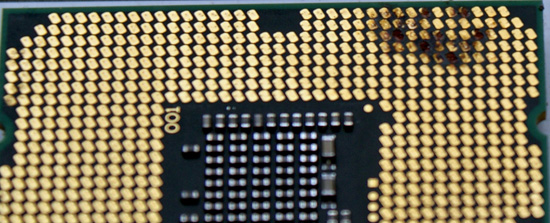
What happens after several extreme benchmark runs...
If you noticed something weird in the pictures then you understand the title of our article. We have what seems to be a potentially serious issue with proper socket loading on several P55-based motherboards when overclocking to the limit. We are of course not the only ones experiencing the problem as several of our overclocking peers have run into the same problem.
Normally we do not worry too much about mishaps during extreme overclocking testing as they are typically caused by factors outside of the supplier’s control. The overriding concern is that we have damaged every motherboard in our possession for the P55 overclocking (extreme) shootout as well as two very expensive i7/870 processors. These problems are the cause of a single component and are repeatable. As such, we thought we would provide details on current problems and will provide an update once all of the motherboard manufacturers affected have had a chance to properly respond.
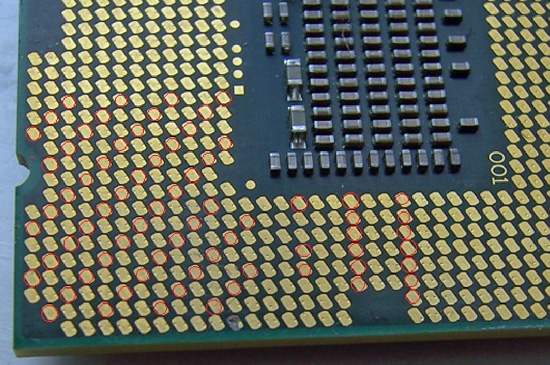
We draw your attention to the fact that the processor shown in this pictures exhibits signs of insufficient pin-to-pad contact (little to no contact) in what is a rather reproducible pattern with Foxconn manufactured 1156 sockets. As soon as an end-user mounts a CPU in a socket and latches the clamp mechanism, each pin should leave a notable mark on the associated pad.
We've marked locations where this does not seem to have happened, showing what appears to be a significant reduction in the number of VCC/VSS pins for proper power delivery, and certainly not at the right load line resistance. Damage resulting from highly overclocked use in these types of situations is not solely limited to the processor; let’s take a look at what happened to some of the motherboards in which these CPU were seated.
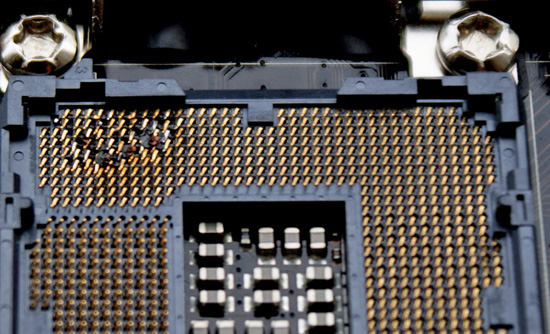

When Intel publishes socket specifications and design tolerances, it's up to component manufacturers to strictly adhere to them when designing, manufacturing, testing and ultimately selling their "compliant" components. Of course, that's not to say Intel could not have goofed when releasing their specification, leaving out a crucial tolerance or such. It could happen, but not likely. For the time being, let's assume that's not the case; seeing as how processors installed in sockets built by other companies have exhibited no such issue in testing to date.
At first glance, one might be inclined to think LGA-1156 based processors are intolerant of high-end overclocking, almost as if by design. This is correct to some extent; a quick glance at Intel’s white papers for socket 1156 CPU’s reveals that there are around 175 pads for VCC compared to over 250 for socket 1366 CPU’s. This means socket 1156 has around 66% of the current capacity of socket 1366, the caveat being that when overclocked, processors from both platforms draw similar levels of current.
When overclocked above 4GHz, processors from both platforms will draw around 15-16 amps via the EPS 12V rail to VCC, VTT and some of the other sub –system power rails under full 8 thread load from the Intel burn test (Linx). Assuming 85% PWM efficiency, we’re looking at power draw in the region of 130-140w to VCC on both platforms. The facts point toward tighter current handling tolerances for socket 1156 when compared to socket 1366, especially when it comes to non-connection of VCC/VSS power delivery pins.
Fortunately, we think we've been able to isolate pin to pad contact issues to one particular brand of parts. Physical inspection and end-user reports all but confirm the issues only affects sockets manufactured by Foxconn at this time. The only known alternative sockets in the wild are made by LOTES or Tyco AMP. We happen to have a couple of boards from EVGA using the LOTES/Tyco AMP sockets and MSI/DFI using the LOTES socket design, and thus far those boards have been issue free given highly similar operating conditions. In fact, we’ve managed to push our LGA-1156 processors further in heavy load tests on boards made using LOTES/Tyco AMP sockets than those made with sockets from Foxconn; something we’re not putting down solely to coincidence.
So far, EVGA is the only company we know that uses sockets exclusively from LOTES on their top-tier P55 boards - for example, the EVGA P55 Classified 200, model E659. This by the way may be the onus behind the decision to market the board’s “300% More Gold Content” socket statement as a purchasing option point. If you find yourself shopping for an EVGA P55 FTW, model E657, you've got a 50/50 chance of buying one with a Tyco AMP socket design (using a LOTES backplate), as opposed to one made solely with Foxconn's, the same goes for MSI and DFI who have batches of boards in the retail channel using LOTES sockets (although we're not entirely sure on socket specifics at this point). DFI told us earlier they have dropped usage of the Foxconn sockets completely until further notice. We hear the LOTES and Tyco AMP sockets are in short supply, which is probably why Foxconn's been able to fill the void in the market with what we believe to be a lower quality alternative for the extreme overclocker.
We took one of our damaged CPU’s and inserted it into one of the EVGA (LOTES/Tyco AMP) boards and took a few pics to show contact scoring and a side by side compare to the original Foxconn socket indents.
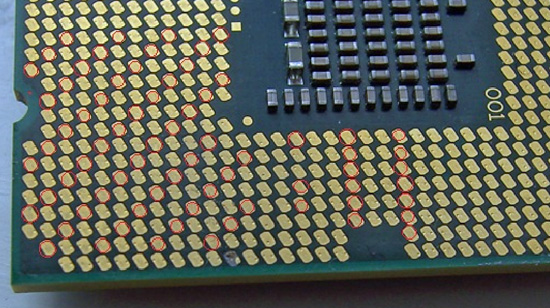
Foxconn 1156 Socket Installation
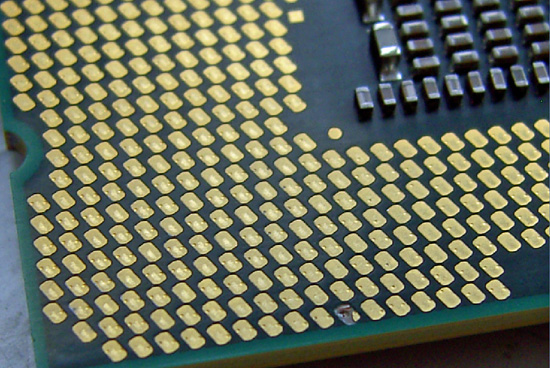
Tyco AMP / LOTES 1156 Socket Installation
Note how from a variety of angles certain pads show no evidence of contact from a Foxconn pin at all. Both the Tyco AMP and LOTES sockets have a larger pin/pad contact surface area leaving a slight scuff mark in the central area of each pad. In light of this, what we will say is that if you’re thinking of doing extreme overclocking on a board built using Foxconn's socket 1156, think again. Or, at least check your CPU for evidence of proper pin-to-pad contact.
We have not had any problems with air or water cooling overclocking up to 4.3GHz, although we do have a i5/750 that has developed a few dark pads after a thousand hours or so of constant overclocking. However, none of the boards have developed pin problems so we feel very safe in saying that any problems will probably occur only in extreme overclocking scenarios.
We also realize that partial responsibility for some of the less than acceptable CPU installations may be in fact due user installation errors. However, if users are screwing this up by doing nothing different than what they've always done when it comes to handling and installing LGA-type processors, then it's hard for us to find fault with the installer. Be aware of this situation and study the pin imprint on the CPU pads and make sure you have good contact on the VCC/VSS power delivery pads before pushing the system too hard.
















273 Comments
View All Comments
JDD - Monday, October 19, 2009 - link
Seems to me that earlier in the article people were saying that not all the pads were making contact. Going back to the design with the pins on the CPU, when it was inserted into the socket there were contact with every pin on that chip regardless of what that pin was used for. Why should this be any different? The correct number of pads we designed into the chip and all should make contact . Where not even talking about turning the thing on, just inserting it into the socket. If it was designed this way it should work this way. If Intel didn’t want all the pads to make contact I would think they would have made less of them and made each one bigger. I don’t see what all the debate is about? If the pad was put there is should be used for something.moronsworld - Monday, October 19, 2009 - link
Overclocking shows evidence to some degree on how your system will perform in the long run. Even if it might not affect you right now in the long run these foxconn cheapened boards will harm your cpu in the long run. If your contacts are off by a little bit, the negative affects of that will build up overtime and in the long run will burnout your cpu faster than normal. So I suggest you not listen to these foxconn/intel monkeys that say that its ok to have a foxconn board. Whoever is saying that these foxconn boards are ok if you're not gonna OC is either a foxconn worker, intel worker or just a plain monkey who doesn't understand a think about computers. Oh and please someone delete the post above me that's trying to advertise clothes.mudman - Monday, October 19, 2009 - link
Somehow I feel it maybe a way from Intel to discourage "extreme" overclocks. Maybe this is their way of capping clockspeeds to 4GHz. Any higher than that and there goes your 1156 setup. If you wanna go higher, try 1366...safaan - Sunday, October 18, 2009 - link
Hello all,I have ordered just last weak a new Intel i5 and Asus P7P55D. And then I read this article on Friday.
What should I do? I don't have in plan to overclock processor but still as you said it can happen once. And no warranty will be there.
What would happen If I choose MSI P55-CD53? How can I be positive that it has Lotus chipset? And do you think Lotus if 100% without this problem?
And which motherboard do you recommend if I choose Core 2 Duo LGA 775 processor?
Thank you.
Safaan
ClagMaster - Sunday, October 18, 2009 - link
Be cool. Don't panic. You made a great choice. Accept the parts and upgrade your new computer and enjoy it. The i5/P7P55D should provide you with years of service since you will not overclock it.Please read my comment on the preceeding page about this article. This article is discussing a socket failure during extreme overclocking (>160W) where currents and voltages are sufficiently high to cause pin/land arcing and pin melting and distortion.
Extrapolating this performance to lower voltages and currents of normative operation (95W) is bogus (inappropriate) and will not cause these failures.
The article discusses pin contact on the basis of dimples found on i5/i7 that were placed there by factor test devices. Some lands do not have these dimples and the author claims they are evidence the Foxconn 1156 socket pins are not contacting these lands. And attibutes this as evidence of non-existent pin contact and the cause of these failures. This is a nonsense.
dingetje - Sunday, October 18, 2009 - link
Clagmaster forgot to mention that he will refund your money when your cpu gets fried ;)Rajinder Gill - Monday, October 19, 2009 - link
Foxconn say they fixed burnout issues by identifying a socket problem back in May. Apparently they had already sent sample sockets from the first Intel spec out to some of the vendors though. In July, two vendors suffered socket burn issues in house and reported this back to Foxconn. Foxconn explained the specification change to those vendors and the vendors continued to purchase socket stock from Foxconn.A recent benching session of single thread of 32m drawing around 7.5 amps from the EPS 12v line @ 5GHz lead to 2 ROG boards burning out, one is mine another a clasoe friend - same bench and same current draw.
I was also sent an EVGA E657 around this time without full retail box just to beta test. That board had a Foxconn socket (unbeknown to me), after an OC session at around 4.8GHz on one fo my CPU's one of the CPU pads had fused to one of the pins.
DFI sent a board to a user to beta test, he OC'd to 4.7 on air and his socket burned out too (Foxconn socket). Most of this took place after July. This was supposed to be the revised Foxocnn socket. The revision cites a new top plate being used to correct problems.
Now we've got reports of some retail boards from ASUS too, one during a gaming session at 4.1GHz. so yes all overclockied, with the only conecerning burnouts being the single 32m ones which draw very little current to VCC.
So, a bit of a weird mess and some vendors are not using the Foxconn parts until they are sure they are ok. DFI, MSI and EVGA have moved over to LOTES and TYCO AMP exclusively for P55.
later
Raja
ClagMaster - Monday, October 19, 2009 - link
The failures occur during operation during extreme overclocking where voltages and currents. Though I admit an overclock at 4.1 Ghz is not so extreme.Raja. What is so different about Foxconn relative to LOTES or TYCO AMP LGA 1156 sockets? Did they change the pin alloys to something cheaper, less conductive and oxidation resistent?
Still, I would not send back a P55 motherboard with a Foxconn socket because of this extreme overclocking issue based on what I know of the physics of arcing and conduction. That is because I do not overclock and for normal currents and voltages arcing should not occur.
If I were Asus, MSI or EVGA I would not accept a return of an undamaged motherboard.
Rajinder Gill - Monday, October 19, 2009 - link
Physically it's really hard to tell. Foxconn say their revision is in the top plate, but I have not seen anything other than the one I have on my boards here. Further a report from DFI revealed the user issue I reported above from mainland China (that was single thread 32m at 4.7Ghz though).If I get any more info on this I'll update.
BTW 32m single thread at 5Ghz only darwas about 60w to VCC. So it is a little scary.
later
Raja
ClagMaster - Monday, October 19, 2009 - link
Well, I am interested in what you find out.Later :)